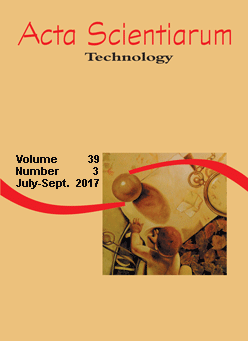<b>Application of particle swarm optimization in inverse finite element modeling to determine the cornea´s mechanical behavior
DOI:
https://doi.org/10.4025/actascitechnol.v39i3.29884Palavras-chave:
inverse analysis, finite element method, swarm intelligence, hyperelastic parameters, human corneas.Resumo
Particle Swarm Optimization (PSO) was foregrounded by finite element (FE) modeling to predict the material properties of the human cornea through inverse analysis. Experimental displacements have been obtained for corneas of a donor approximately 50 years old, and loaded by intraocular pressure (IOP). FE inverse analysis based on PSO determined the material parameters of the corneas with reference to first-order, Ogden hyperelastic model. FE analysis was repeated while using the commonly-used commercial optimization software HEEDS, and the rates of the same material parameters were used to validate PSO outcome. In addition, the number of optimization iterations required for PSO and HEEDS were compared to assess the speed of conversion onto a global-optimum solution. Since PSO-based analyses produced similar results with little iteration to HEEDS inverse analyses, PSO capacity in controlling the inverse analysis process to determine the cornea material properties via finite element modeling was demonstrated.
Â
Downloads
Downloads
Publicado
Como Citar
Edição
Seção
Licença
DECLARAÇíO DE ORIGINALIDADE E DIREITOS AUTORAIS
Declaro que o presente artigo é original, não tendo sido submetido í publicação em qualquer outro periódico nacional ou internacional, quer seja em parte ou em sua totalidade.
Os direitos autorais pertencem exclusivamente aos autores. Os direitos de licenciamento utilizados pelo periódico é a licença Creative Commons Attribution 4.0 (CC BY 4.0): são permitidos o compartilhamento (cópia e distribuição do material em qualqer meio ou formato) e adaptação (remix, transformação e criação de material a partir do conteúdo assim licenciado para quaisquer fins, inclusive comerciais.
Recomenda-se a leitura desse link para maiores informações sobre o tema: fornecimento de créditos e referências de forma correta, entre outros detalhes cruciais para uso adequado do material licenciado.



















